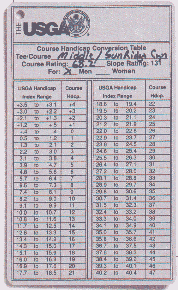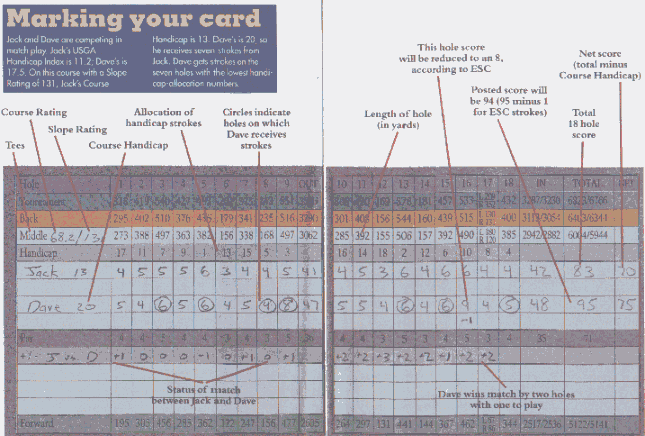|
GOLF DIGEST BASICS: - Handicap Guidelines
April, 1997
1. Post every score. Under the U.S. Golf Association Handicap System you must post every score that you make, whether it is a casual round or a tournament round, whether or not you're playing with a partner, and even if you pick up on some holes. Any time you play 13 or more holes, you are required to post the score for handicap purposes. If you do not play a hole or play it other than under the principles of the Rules of Golf, the hole score is equal to par plus any handicap strokes you're entitled to receive on the hole.
2. Understand Equitable Stroke Control. There is a limit of strokes you can post on a hole depending on your course handicap. Equitable Stroke Control (ESC) is the downward adjustment of individual-hole scores to make handicaps more representative of a player's potential ability. If you have the following 18-hole Course Handicap, here's your maximum score for each hole:
Course Handicap 9 or less: double bogey.
10-19: 7.
20-29: 8.
30-39: 9.
40-above: 10.
(Some states are testing a procedure that essentially allows a low handicapper, for example, to take no more than a double bogey.)
3. Post your most likely score. If you pick up on a hole, post your most likely score (provided it's less than the maximum of ESC). For example, if you're lying 3 on a green 20 feet from the hole and you pick up, your most likely score would be 5, so you post the 5, not a 7.

4. Know how to use the Slope System. You never play with your USGA Handicap Index. The Handicap Index is a decimal number that you use only to convert to what is called a Course Handicap, which is a whole number and the handicap you play with. The Course Handicap varies depending on the course you're playing. You convert your Handicap Index to a Course Handicap by looking at a table posted at the course (see table at left).
5. Playing from different tees. If people are competing from different tees, the person playing from the higher-rated tees � the tees with the higher Course Rating � receives additional strokes equal to the rounded-off difference in Course Rating. For example, a woman playing from forward tees with a USGA Course Rating three shots higher than the men's course rating from the white tees receives three additional shots against a competitor who is playing from the white tees.
� DEAN KNUTH
USGA senior director of handicapping

Figuring Your Handicap
Most golfers enter their scores on a computer at their course that works through a regional or state golf association. This is how your Handicap Index is calculated:
Determine the Handicap Differential for each score (Course and Slope Ratings vary from course to course):
Adjusted gross score minus the Course Rating:
89 - 73.5 = 15.5.
Difference times 113 (the Slope Rating of a course of standard difficulty):
15.5 x 113 = 1,751.5.
Result divided by the course's Slope Rating:
1,751.5 � 134 = 13.0709
Handicap Differential (rounded):
13.1
The USGA ideally uses the best 10 differentials of the most recent 20 scores to determine Handicap Index. ut you can hve an official USGA Handicap with as few as five scores. The following is based on nine scores using the lowest three differentials.
Total of the lowest three Handicap Differentials:
51.8
Average (51.8 � 3):
17.266
Multiply by .96 (a ratio that makes handicaps equitable for all players):
16.57
Delete digits after tenths:
16.5
The Handicap Index is 16.5.
�TOPSY SIDEROWF
|




